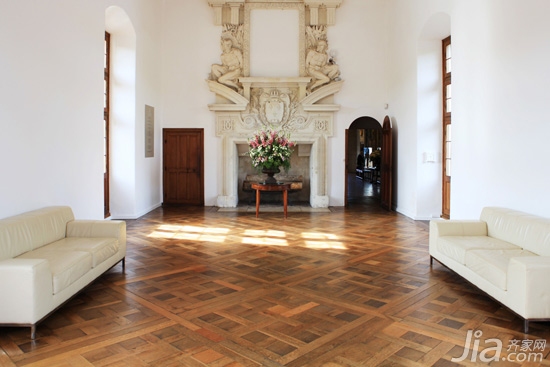Antibacterial flooring is what antibacterial flooring really antibacterial it
What is an antibacterial floor?

Antimicrobial wood flooring is simply a certain amount of antibacterial agent added to the floor material, after processing. It can inhibit the proliferation of bacteria on the surface, and thus achieve long-term health and safety. At present, antibacterial flooring has gradually attracted the attention and favor of consumers.
The reason is mainly due to the increasing living standards of people, the continuous improvement of health and environmental protection awareness, especially the impact of epidemic diseases such as “SARS†and “bird fluâ€, which has caused the majority of consumers to care and attach importance to the home environment. Increasingly higher.
The same as the antibacterial wood floor, its antibacterial composition is also not the same. Generally classified, antibacterial agents can be divided into organic and inorganic categories.
At present, in the wood floor market, products using inorganic antibacterial agents are more common. The inorganic antibacterial agent is divided into silver ion antibacterial agent, photocatalyst antibacterial agent and zinc oxide whisker three.
The silver ion antibacterial agent utilizes the antibacterial ability of silver and fixes the silver ions on the surface of a porous material such as zeolite by means of physical adsorption such as ion exchange.
The main component of the photocatalyst antibacterial agent is nano-sized titanium dioxide, which absorbs light and is in a state of high energy, and transfers high energy to the reactants to cause a chemical reaction, which serves the purpose of eliminating planktonic bacteria, molds, and dust mites in the air. . Zinc oxide whiskers can react with oxygen and moisture in the air under normal conditions to release oxygen atoms, hydroxyl radicals, negative oxygen ions and other antibacterial substances. At the same time, zinc ions can also react with enzymes in bacteria to kill bacteria.
These three kinds of inorganic antibacterial agents do not have a grade level, so consumers should also consider comprehensive indicators such as quality, price, and after-sales service of the original brand. At present, wood floors with antibacterial properties appearing in the wood floor market are mostly brand products that have experienced experience in the wood floor market in recent years and have a certain market share.

What is the difference between "antibacterial" and "bactericidal"?
So, what is the role of antibacterial flooring in the end? Is it preventing the growth of bacteria or resisting bacterial invasion or completely killing bacteria? Zhang Yingzhan pointed out that antibacterial and sterilizing are different concepts and cannot be confused with antibacterial and sterilizing.
Antimicrobial laminates on the market today are based on the addition of antibacterial agents to the substrate, which can only inhibit the bacteria on the surface of the floor. There is no way to kill the bacteria in the air. Facing the enduring antibacterial concept boom in the country, “Antimicrobial flooring will be the future trend of the flooring industry. However, for the time being, there are still many technical issues that are immature and need to be solved, especially antimicrobial safety. problem."
Insiders pointed out that bacteria are produced on the floor, mainly in the process of use, and the gap between the floor and the floor is a “hotbed†for the accumulation of bacteria, dust mites and other bacteria. Simply adding a so-called antibacterial agent to the floor production process, you want to eliminate these living bacteria. Some of them are not practical. At present, many companies claim that their products use nanomaterials.
In this regard, experts say that nano-level fungicides are "all-in-one" when they destroy cells. This is called nanoparticle toxicity. Many antibacterial floorings do this by continuously releasing nanoparticles to kill germs. For a well-qualified anti-bacterial floor, how much nano-particles should be released will not cause harm to the human body? This is a problem that needs to be studied and tested by experts.
Some businesses even claim that antibacterial flooring can kill bacteria in the air, which is entirely an irresponsible propaganda. Antibacterial agents added to the substrate can only inhibit bacteria on the surface of the floor, but they cannot kill bacteria in the air anyway.
Antibacterial floor detection has not yet been introduced
Experts of the China Forest Products Industry Association's wooden flooring special committee told the reporter that at present, there is no unified antibacterial floor technology testing standard, how long the antibacterial floor antibacterial effect can last, and which germs can resist, and there are no specific standards. In addition, even if the product has an antibacterial effect, the effect is not once and for all. If only the surface is coated with an antibacterial agent, after the antibacterial agent comes off, its antibacterial properties will be compromised. Antibacterial floorings that are sold on the market have not been certified by the national authorities. Enterprises promote their products and exaggerate their antibacterial efficacy. Consumers should be cautious about it.
Related content Recommended reading:
How to choose a good floor for your pet
Bamboo flooring is good or bad bamboo flooring advantages and disadvantages
Floor installation loss know how much decoration to avoid spending money
Home improvement floor to buy quality and aesthetic skills
The difference between solid wood flooring and solid wood flooring
Tips: If you want to know more about the floor, you can pay attention to the information of this website or go to this website to find more floor products!
Flooring Flooring Selection Flooring Home Renovation Home Improvement Home Renovation Home Renovation Home
Air Conditioner,Split System Aircon,Split Unit Air Conditioner,Multi Split Air Conditioner
LONG TERM ELEC. CO., LTD , https://www.longterm-hvac.com